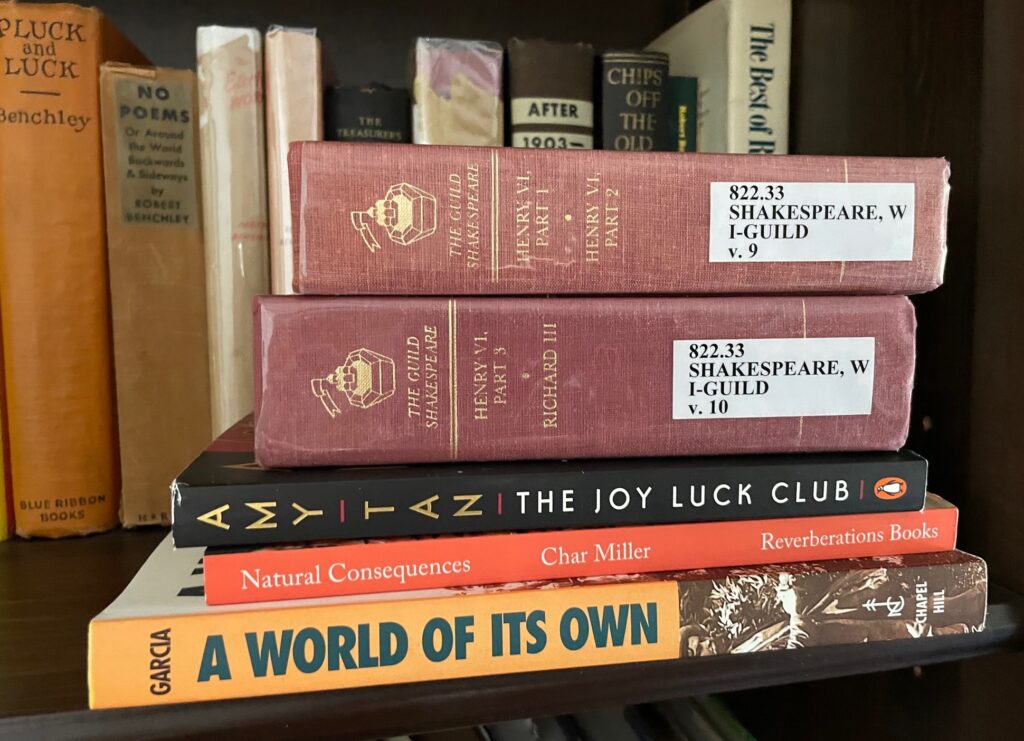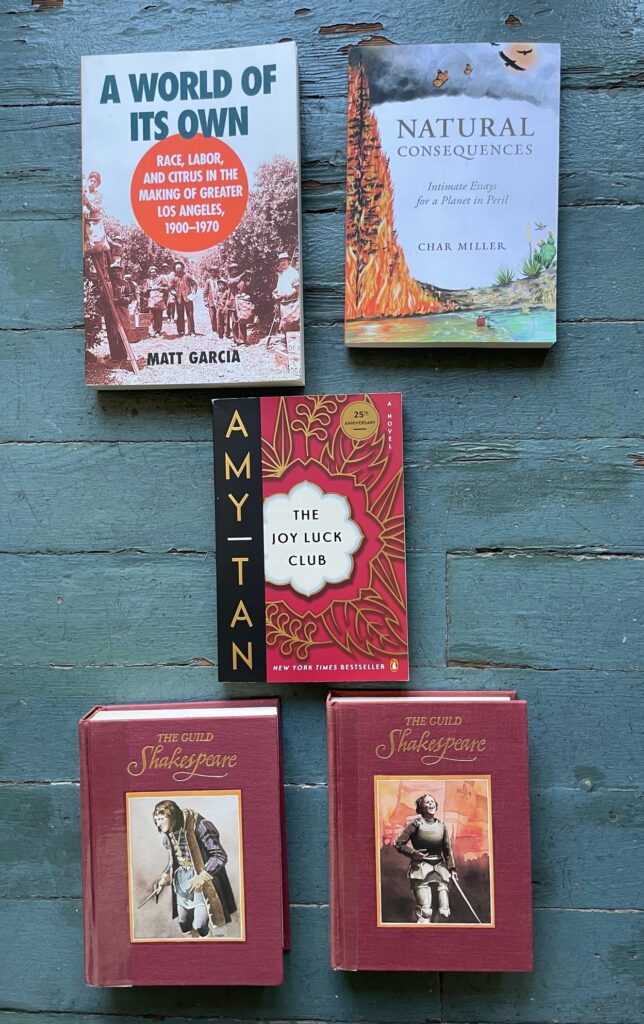Books acquired: “A Kiss Across the Ocean,” Richard T. Rodriguez; “Through the Doors of the Mission Inn, Vols. 1 and 2,” Joan Hall; “When Teddy Came to Riverside,” Glenn Wenzel
Books read: “A World of Its Own: Race, Labor and Citrus in the Making of Greater Los Angeles, 1900-1970,” Matt Garcia; “Natural Consequences: Intimate Essays for a Planet in Peril,” Char Miller; “The Joy Luck Club,” Amy Tan; “Henry VI Part 1, Part 2, Part 3,” William Shakespeare
Fall to, readers! Time to account for how we spent the final days of summer and the first days of autumn, at least from a book-ish standpoint.
I managed to finish six, thanks to extending the month an extra four days and delaying the Reading Log. An explanation awaits. To summarize the above titles, my month-plus involved a nonfiction book about the Inland Empire and San Gabriel Valley, a second nonfiction book on the environment that has a focus on Claremont, a popular modern novel and three plays about the 15th century.
“A World of Its Own” (2001): Garcia focuses on a few cities in LA’s eastern hinterlands to explore the Mexican American experience via the citrus industry, dance halls, a white-owned dinner theater with Latino performers and fumbling attempts by whites at intercultural understanding. Lots of valuable information, although the writing can be academic at times. (A gift in 2006 of the late Cande Mendoza.)
“Natural Consequences” (2022): A slim collection of 40 short essays about California wildfires, forests, drought and public lands by an environmental historian and gifted writer. A section at the end uses Claremont, the author’s home and mine, as a microcosm, touching on development in a fire zone, the delights of a city center with bakeries and coffee spots, and old contractor stamps on sidewalks. (Advance copy from the publisher.)
“Joy Luck Club” (1989): Highly enjoyable novel made up of a series of stories centered on women and their mothers and mothers and their daughters. Or did you know that already? (Free copy from the Rancho Cucamonga Public LIbrary’s Big Read in, uh, 2016. Is it too late for me to participate? But basically I listened to an audiobook version.)
“Henry VI Part 1” (circa 1590): A decent if awkward start to Shakespeare’s run of history plays. The portrayal of Joan of Arc as a tart who was in league with demons is certainly, er, different. Best, cruelest line, spoken in disdain above the corpse of a noble slain on the battlefield: “Him that thou magnifi’st with all these titles/Stinking and fly-blown lies here at our feet.” (This and next two are from my 1984 Riverside Shakespeare anthology bought as a college textbook, although I borrowed these more portable volumes from the Pomona Public Library.)
“Henry VI Part 2” (circa 1591): Reads more like the Shakespeare we know compared to Part 1. And, as I near the end of the Bard’s canon, it was a pleasure to finally encounter the famous line “First thing we do, let’s kill all the lawyers!” The context is that it’s spoken by an anti-intellectual idiot during a half-baked insurrection. Who says Shakespeare has nothing to tell us anymore?
“Henry VI Part 3” (circa 1592): Kings are captured, kings escape; partisans switch sides; Edward throws over his fiancee; various people are stabbed. The passive Henry can barely rouse himself to defend his crown, leaving that to his son and wife, both strong characters, and friends who might wonder why they are bothering, because Henry just isn’t that into them. As our young people say, it’s a lot.
The “Henry VI” trilogy of plays are not in the first (or second) rank of Shakespeare, but they’re an interesting extended effort and his first history plays, recounting the War of the Roses. They continue into a fourth play, “Richard III,” which is better, and which I read a few years back. Anyway, I extended my reading month just to read “Part 3,” which I started Sept. 30 and wrapped up Oct. 4.
“World” had a lot of interest for me and I really should’ve read it years ago. It’s obviously for the local-history-minded. “Joy Luck” is of course a modern classic and a rare novel where the characters are almost all female.
What did you all read in September? Rake them all together like fallen leaves and tell us about them, please.
Next month: Traveling slowly.


